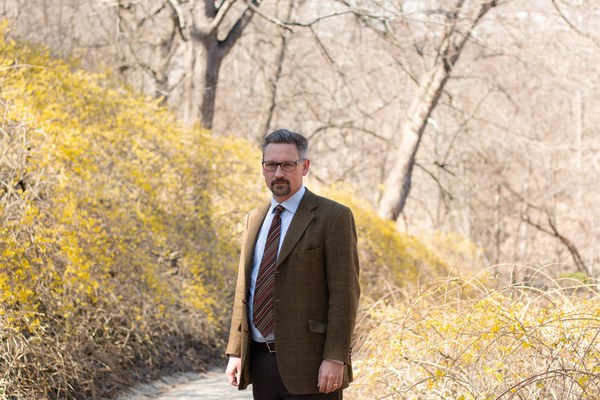Thomas Arentzen works as a researcher in the Department of Linguistics and Philology at Uppsala University and was a 2018–2019 fellow in Byzantine Studies. His research report, “Blushing Trees, Embracing Trunks: Byzantine Arboreal Behavior,” asked how Byzantine Christians imagined trees to behave.
Q&A with Thomas Arentzen
The Plant Humanities Initiative at Dumbarton Oaks investigates the significance of plants to human culture and the agency of plants. How does your research engage with these themes?
I work on human notions or interpretations of plants. It was fairly accepted in Byzantium that trees had souls. The question for me is, to what degree did Byzantine people imagine trees had or could have agency?
There are several examples in Byzantine texts, early and late, where trees do things: leaves heal humans, trunks bow down toward Christ or the Virgin Mary, trees interact and greet each other. One tree flies. Some stories feature exceptional or miraculous trees, while shrubs behave more humbly. The point is that for Byzantine Christians, arboreal didn’t have to mean passive. Trees—at least some of them—actively interacted with the divine and human realms.
There is enough evidence that you can’t say, as some moderns have, that for early Christians, trees were basically dead wood used for burning, or they were merely good to think (mythologically) with. Way too often, we class Christian history as only what’s in the Bible or in the writing of Church Fathers. But I think most church historians, or other historians for that matter, can tell you Christianity and Christian culture is much more complex. There is no Christmas tree in the Bible, you know. No religion just emerges out of a book. And, to be sure, there’s tree agency in the Bible, too!
The Tree of Life (in Paradise) and the tree of the Cross are major providers of symbolic pregnancy in the Christian interpretation of trees. Yet the very materiality of trees matters too. Various stories show trees had special meaning for Byzantine Christians. Take the dendrites, ascetics who lived for years in trees—it seems significant that while other saints chose caves or pillars, they chose trunks and branches.
The Swedish Research Council has funded the four-year project Beyond the Garden: An Ecocritical Approach to Early Byzantine Christianity, which I conduct. I’m happily delving into, exploring, and investigating the role of trees in the religious world of Byzantine Christians.
What’s an example of a specific Byzantine tree with agency?
Take the story of Saint Nicholas the Younger, which is told in two texts in the Dumbarton Oaks Medieval Library volume Saints of Ninth- and Tenth-Century Greece. Both texts describe Saint Nicholas as living in a close relationship with a tall oak.
The story goes that Nicholas is a military officer sent to Thessaly to defend the Byzantine Empire against Muslim enemies. When attacked, Nicholas and his men flee into an idyllic place in the hills, until the enemies find them and kill most of his men. Nicholas flees again and finds an even more secluded place in the middle of a forest on a mountain. A beautiful tall oak towers next to a spring. Nicholas decides to live there, inside (or in a cave next to) the tree.
Eventually the enemies track him down and kill him. Then, say the stories, his soul is embraced and welcomed by Christ, while his body lies on the ground next to the tall oak. Immediately, the tree embraces his body and takes it inside itself. The oak, in a way, saves his body. That’s a very clear kind of agency.
After that, there’s a miracle story about a sick person from Thessaloniki healed by either the oak or the relics of Saint Nicholas the oak keeps inside itself. A scent or fragrance that sanctifies humans and trees emanates from it. The tree in these stories is an active agent in a relationship with the saint and in relation to the people who seek healing.
How have you collaborated in your time at Dumbarton Oaks?
Dumbarton Oaks is a place of collaboration. With Byzantine colleagues I started translating sixth-century Greek poems and songs (kontakia), which I have written about in my book The Virgin in Song: Mary and the Poetry of Romanos the Melodist. The translations might be included in a forthcoming Dumbarton Oaks Medieval Library volume. [Director Emerita of Byzantine Studies] Alice-Mary Talbot has been very helpful to me. And I was thrilled by all the useful ideas and suggestions from Garden and Landscape colleagues for my research about trees. It may seem like people who study gardens/landscape and people like me who study Byzantium are on two different planets. When you’re here, the two converge. And when you sit under a tree in the Dumbarton Oaks Garden, it is difficult to know why one would want to do anything else.
Julia Ostmann is postgraduate writing and reporting fellow at Dumbarton Oaks. Photo by Elizabeth Muñoz Huber, postgraduate digital media fellow.

